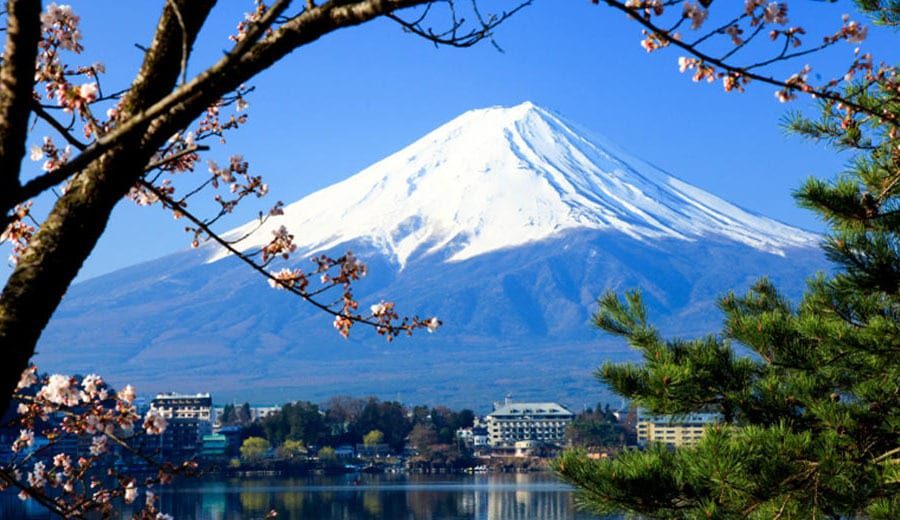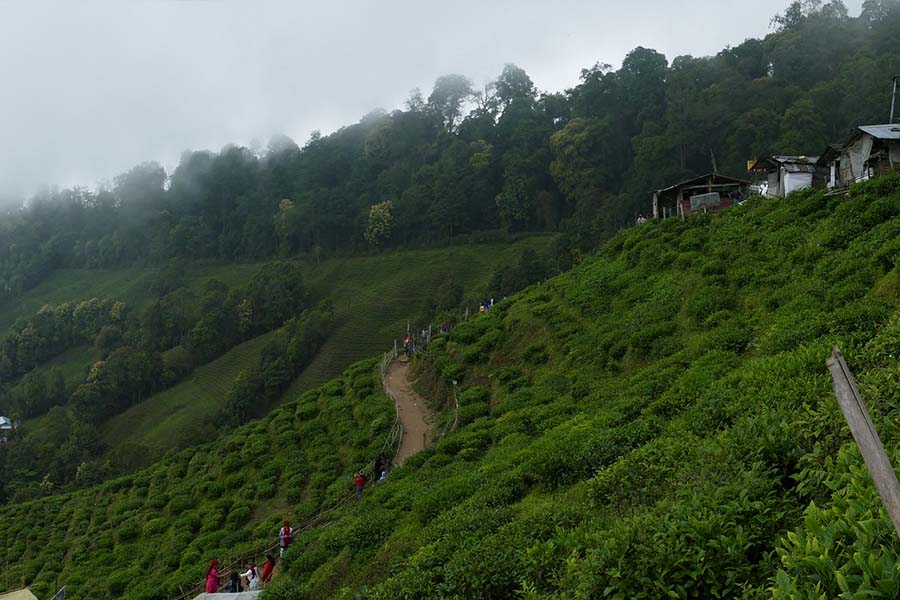Mount Fuji
Mount Fuji located on Honshu Island in Japan the most prominent mountain in Japan
Mount Fuji with 3776 meters, is situated on Honshu Island and is the highest and most prominent mountain in Japan. It is standing tall as a dormant volcano that erupted last in the year 1707. However, many geologists have differed saying that it is still in its active state. Mount Fuji is considered an object for pilgrimage by many artists and poets and has inspired many creations by them. Many people climb to its top during the summer months too. It is one of the three holy mountains of Japan along with Mount Tate and Mount Haku. This marvelous and historic place of scenic beauty is listed in the World Heritage Sites of UNESCO.
This is located near the Pacific Coast of Honshu, which is on the west of Tokyo. It stands on the border between Yamanashi and Shizuoka Prefectures. On clear days, it can be seen from Tokyo and Yokohama. On a train trip from Tokyo to Osaka, you can also enjoy the enchanting view of Mount Fuji from around Shin-Fuji Station on the right side of the train. Clouds often lead to poor visibility of Mount Fuji. So, consider yourself fortunate, if you can get a clear view of Mount Fuji. Visibility is better in the colder seasons, especially in the early hours of the morning and late evening hours.
Top attractions
Climbing Mount Fuji:
Climbing Mount Fuji is a unique and challenging experience that offers breathtaking views of the surrounding countryside. The official climbing season usually runs from July to mid-September and offers several trails to reach the summit, including the popular Yoshida Trail. However, climbing Mount Fuji can be strenuous and requires proper preparation and equipment. Visitors should be in good physical condition, bring plenty of water and food, and be prepared for sudden weather changes.
Fuji Five Lakes:
The Fuji Five Lakes area is a popular tourist destination located at the northern foot of Mount Fuji. The five lakes offer a variety of outdoor activities such as boating, fishing, and hiking. Visitors can also enjoy scenic views of Mount-Fuji and the surrounding natural beauty, including forests, hot springs, and waterfalls. The area is also famous for its autumn leaves, which attract many visitors each year.
Arakurayama Sengen Park:
Arakurayama Sengen Park is a popular spot for viewing Mount Fuji and the surrounding countryside. The park is famous for its cherry blossom viewing in spring, and visitors can enjoy a panoramic view of Mount Fuji from the park’s observation deck. The park is also home to the Arakura Sengen Shrine, which is dedicated to the goddess of Mount Fuji.
Oshino Hakkai:
Oshino Hakkai is a collection of eight ponds that are fed by underground springs. The ponds are considered one of the clearest sources of water in Japan and are surrounded by lush vegetation and scenic views. Visitors can walk around the ponds and enjoy the natural beauty of the area, including traditional Japanese gardens, waterfalls, and hot springs.
Chureito Pagoda:
Chureito Pagoda is a five-story pagoda located on the side of Mount-Fuji. The pagoda offers breathtaking views of Mount and the surrounding countryside and is a popular spot for viewing cherry blossoms in spring. The pagoda is also an important site for Shinto rituals and is dedicated to the spirits of those who died in the Pacific War.
Lake Kawaguchi:
Lake Kawaguchi is one of the five lakes surrounding Mount Fuji and is a popular destination for boating, fishing, and other water activities. Visitors can also enjoy scenic views of Mount Fuji and the surrounding natural beauty, including forests, hot springs, and waterfalls. The lake is also famous for its autumn leaves, which attract many visitors each year.
Fuji World Heritage Center:
The Mt. Fuji World Heritage Center is an interactive center that offers exhibits and displays about the history, culture, and natural beauty and its surrounding area. Visitors can learn about the geological formation of Mount Fuji, its cultural significance, and the unique flora and fauna found in the area. The center is a great place to learn about the history and culture of Mount Fuji before visiting.
Sengen Shrine:
Sengen Shrine is dedicated to the goddess of Mount Fuji and is an important site for pilgrimages and traditional Shinto rituals. The shrine is located at the base of Mount Fuji and offers beautiful views of the surrounding countryside. Visitors can take part in traditional rituals and learn about the history and culture of Mount Fuji. The shrine is also a popular spot for cherry blossom viewing in spring.
How to reach
can be reached by several modes of transportation:
- By Train: The quickest and most convenient way to reach Mount Fuji is by train. From Tokyo, visitors can take the bullet train (Shinkansen) to Shin-Fuji Station, which is located near the base of the mountain. From there, local buses can take visitors to various attractions at the base of Mount Fuji.
- By Bus: Visitors can also take an express bus from Tokyo to Mount Fuji, which takes about 2 hours. Buses depart from major terminals in Tokyo and stop at various locations near the base of the mountain.
- By Car: Visitors can rent a car and drive to Mount Fuji, but it is important to note that parking near the mountain can be limited and expensive.
- By Private Tour: Private tours are also available, which include transportation and a guide. This can be a convenient option for visitors who want to maximize their time and avoid navigating public transportation.
Regardless of the mode of transportation, it is important to plan ahead and check for road and weather conditions, especially during the climbing season.
Best time to visit
The best time to visit Mount Fuji depends on personal preferences and the activities you want to enjoy:
- Summer (July to September): The summer months are the official climbing season and offer the best weather conditions for climbing the mountain. The views from the summit are also clearer during this time.
- Spring (April to May): Spring is a popular time to visit here for its cherry blossom viewing. Visitors can enjoy the beauty of the cherry blossoms in the surrounding area, including the Fuji Five Lakes.
- Autumn (September to November): Autumn is a great time to visit Mount-Fuji for its autumn leaves, which provide a stunning backdrop for scenic views of the mountain and surrounding countryside.
- Winter (December to March): Winter is a quieter time to visit, and visitors can enjoy snow activities such as skiing and snowboarding. However, it is important to note that climbing the mountain is not recommended during the winter due to harsh weather conditions.
Regardless of the time of year, visitors should be prepared for sudden weather changes and be aware of road and trail conditions before visiting.
Travel Guide
Here is a travel guide to help you plan your visit:
- Timing: Plan your visit based on the season you prefer and the activities you want to enjoy. Summer is the best time for climbing the mountain, while spring and autumn are popular for their scenic beauty.
- Transportation: Consider the mode of transportation that best fits your needs. The quickest and most convenient way to reach by train, but buses and private tours are also available.
- Accommodation: Book your accommodation in advance, especially during the peak climbing season. There are various options available, including mountain huts, hotels, and campsites, for those who wish to stay overnight.
- Climbing gear: If you plan to climb Mount Fuji, bring appropriate gear, including proper footwear, warm clothing, and a hat and gloves. Consider renting gear if necessary.
- Food and drinks: Stock up on food and water before beginning your climb, as supplies are limited on the mountain. It is also important to stay hydrated and eat regularly during the ascent and descent.
- Respect the mountain: Be aware of the rules and regulations of climbing here, including respecting the environment and following the designated trails. Do not litter and avoid disturbing wildlife.
- Safety: Take necessary precautions and check the weather and trail conditions before climbing. Be prepared for sudden changes in weather and bring appropriate gear.
By following these guidelines, you can have a safe and enjoyable visit here.



